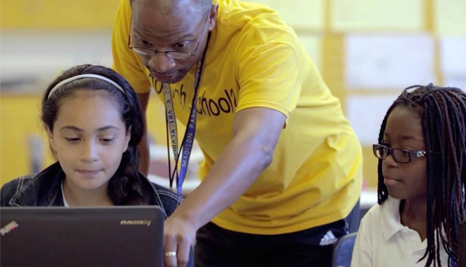Scott Hamilton is the Forrest Gump of education reform, although with a lot more IQ points and fewer chocolates. He worked for Bill Bennett in the U.S. Department of Education and for Benno Schmidt at the Edison Project. He authorized charter schools in Massachusetts, co-founded the KIPP network, quadrupled the size of Teach For America (TFA), and introduced blended learning at urban Catholic schools. He’s been around.
 He’s proud of what he’s done. “There are 40,000 kids in KIPP schools who will have a very different life,” Hamilton says. “Thousands of TFA teachers are having a terrific impact.”
He’s proud of what he’s done. “There are 40,000 kids in KIPP schools who will have a very different life,” Hamilton says. “Thousands of TFA teachers are having a terrific impact.”
But that’s not enough to “move the needle” on American education, he says. He wants to do more.
Now 47, he’s started a new initiative called Circumventure, based in San Francisco. Through surveys, focus groups, field tests, and interviews, Circumventure is asking fundamental questions: Do people want what schools are offering? If not, what do they want? Can technology make it happen?
Hamilton’s “aha moment” came in a conversation with a friend who worked for the Gates Foundation’s global health initiative.
“We’ve spent billions on K–12 with little to show for it,” Hamilton said. “What should we in education learn from global health people?”
“What’s the demand?” is the first question, the global health specialist said. “Do people want what you’re trying to provide?”
“Of course they do!” said Hamilton. Then he thought, “Do they?”
Bill Gates encouraged Hamilton to investigate whether low demand for schooling was causing America’s mediocre academic results. He created Circumventure.
Market Research at the Mall
Since starting Circumventure, Hamilton has become a “mall jumper.” He drives to Bay Area shopping malls, buttonholes parents, and asks what they want for their children. Then he asks the kids what they want from school.
Low-income parents want good schools, he says. But demand for what schools are offering weakens in working-class families and diminishes even more for middle-class parents. One or two steps up the economic ladder, parents say, “I just want my kids to be happy.”
Kids have their own perspective. “The ‘why’ behind education is not clear to kids,” he says. Everyone wants to go to college, but not to get an education. “College is like a bar mitzvah. It’s a rite of passage.”
Being a “good learner” is valued. Being “well educated” is not. “Students think they can learn on their own,” he’s found. “Teens think, ‘I’ll never use geometry. If I need it, I’ll learn it then.’
“Today’s kids are very entrepreneurial,” says Hamilton. “One-third of high schoolers say they’ll start their own business.”
In focus groups, he has met a Philadelphia girl who plans to open her own strip club and a boy who wants to run a saltwater aquarium store.
Kids are focused on “creating their digital brand,” Hamilton says. “How they’re seen online is what matters.” He remembers when people would talk about “discovering who I am.” Now teens say, “I’m creating my brand.” He shakes his head. What used to be exploration is now marketing.
In the past, the family sat down at the dinner table together and ate the same meal, Hamilton recalls. It was meat loaf, mashed potatoes, and peas for everyone. Now dinner is “hyper-personalized.” Everyone wants something different.
People expect education to fit their personal tastes and interests, too. “They like learning what they want to learn and expect to do it online.”
But technology doesn’t work if the motivation isn’t there. And it can’t do everything. Children learn teamwork and citizenship by interacting face to face.
“Young Millennials and their Generation Z siblings” think they don’t need school to learn new things. They’ll do it all themselves—if and when they feel like it. If kids don’t see a direct connection to their own goals, they don’t want to do the work.
“If they’re playing a computer game, they’re willing to dig for 100 treasure chests to win the Golden Sword of Awesomeness,” Hamilton says. But they’re not as willing to work hard in school because the reward isn’t clear to them.
 Circumventure is pursuing ways to put learning directly into the hands of children. Digital learning can be very effective, Hamilton believes. “Students like learning privately in their own time and their own space. If you need to watch the Khan [Academy] video five times no one knows or thinks you’re dumb.”
Circumventure is pursuing ways to put learning directly into the hands of children. Digital learning can be very effective, Hamilton believes. “Students like learning privately in their own time and their own space. If you need to watch the Khan [Academy] video five times no one knows or thinks you’re dumb.”
He lent mini iPads to 18 early elementary school kids and gave them incentives for completing learning pathways in curated math apps. The children averaged eight months of growth in math in just four weeks.
Schools won’t vanish, Hamilton predicts, if only because “people want a safe place for kids in the workday and a place for kids to be with their peers.”
What if today’s kids are not as smart as they think they are?
Hamilton wonders how to persuade the future strip-club owner that she needs to master math and science.
“I don’t yet have a list of solutions,” says Hamilton. Just questions.
From Plato to KIPP
Growing up in Colorado, Hamilton attended “good but not great” public schools. His high school had 3,800 students. “If you wanted a good education, you could get it,” he recalls. If you didn’t care, you could settle for mediocrity.
Interested in politics, he postponed college to work on a senatorial campaign. The campaign manager, who had studied Latin in college, turned him on to classics. Hamilton majored in ancient Greek at Penn. He wrote his senior thesis on the education ideas in Plato’s Republic. “It’s been education ever since,” he says.
Hamilton interned for Secretary of Education Bill Bennett, and then worked as a policy analyst for the department.
He left Washington to work for former Yale president Benno Schmidt, who was starting the Edison Project. Edison, which tried to run public schools at a profit, faltered. But it was there that Hamilton met Stacey Boyd, who became his wife.
 Hamilton became Massachusetts’s first associate commissioner of education for charter schools, recommending which schools would get, keep, or lose their charters.
Hamilton became Massachusetts’s first associate commissioner of education for charter schools, recommending which schools would get, keep, or lose their charters.
Boyd earned an MBA and started a charter school in Boston. (Hamilton recused himself on all matters concerning his wife’s school.) The Academy of the Pacific Rim seeks to combine “the best of the East—high standards, discipline and character education—with the best of the West—a commitment to individualism, creativity and diversity.” Now a high-performing school serving grades 5 to 12, the academy enrolls primarily black and Latino students.
The family left Boston for San Francisco in 1999 when Hamilton went to work for Don and Doris Fisher’s Pisces Foundation. The Fishers, who had started the Gap clothing stores, wanted to “reduce the gap” in achievement between the haves and have-nots, says Hamilton. “They thought education was the way to do that.”
The Fishers’ goal wasn’t to start something new. They told Hamilton to “find what works and make it bigger.”
Boyd suggested Hamilton look into KIPP. She’d met KIPP co-founder Mike Feinberg after she started the Academy of the Pacific Rim in Boston. Hamilton visited KIPP’s two schools in Houston and New York City.
“It was working,” he concluded. He sold the Fishers on expanding KIPP. “Don and Doris said, ‘This looks great. Here’s $15 million. Go do it.’”
Hamilton decided KIPP would not run KIPP schools. “We wanted entrepreneurs to start schools, not administrators.”
Hamilton had seen how his wife used her business school training to build a leadership team and create a culture of learning at the Academy of the Pacific Rim. He asked University of California-Berkeley’s business school to design an intensive leadership training program for people who wanted to start their own KIPP school.
Hamilton became CEO of KIPP and the KIPP Foundation, while continuing to work at Pisces.
In his search for fundable education ideas, Hamilton kept discovering Teach For America alumni who had become innovators and leaders. “The Fishers and I agreed that TFA was addressing a human capital problem for American education. So I went to Wendy Kopp [TFA founder and board chair] and asked if she could grow the size of TFA.” With the Fishers’ help, TFA doubled the size of its teaching corps.
Hamilton served on the TFA board for several years and helped with its reorganization.
“Four years later, we went back to Wendy and asked if she could double the size of the corps again, and she said yes. But this time, before committing millions more, we got Wendy to agree to place a good number of TFA corps members at charter schools and not just district public schools.”
Blend and Save
Hamilton left Pisces, now the Doris & Donald Fisher Fund, in 2007. Then, as a distinguished visiting fellow at the Thomas B. Fordham Institute, he worked on a report exploring the question, “Who Will Save America’s Urban Catholic Schools?”
 A friend said: “Why not you?” So he co-founded Seton Education Partners to develop a new financial model for urban Catholic schools, which faced rising costs and competition from tuition-free charter schools.
A friend said: “Why not you?” So he co-founded Seton Education Partners to develop a new financial model for urban Catholic schools, which faced rising costs and competition from tuition-free charter schools.
“Catholic schools never really recovered from losing the nuns,” says Hamilton. “It used to be one nun teaching 50 kids. Now there’s a lay teacher who makes close to a public school salary teaching 20 kids.”
By this time, Hamilton and Boyd were parents. Boyd now runs the Schoola web site, which creates fundraising tools for schools. The couple’s daughters, a kindergartner and a 3rd grader, attend private schools. “Most anyone in San Francisco who can afford it sends their kids to private school,” says Hamilton.
When their older daughter was four, she had taught herself to read using software. Hamilton was intrigued.
Seton worked with Mission Dolores Academy, an independent K–8 Catholic school in San Francisco, to introduce “blended” learning. Students split their time between mastering lessons on computers and working with the teacher. Class size rose, lowering costs, but the rotation model let teachers “work with small groups and build a closer relationship with kids,” says Hamilton.
Seton has expanded the blending learning model to three other Catholic schools.
But Hamilton decided he needed to do more. “I can change a thousand Catholic schools’ economics and results, but that won’t move the needle.
“The focus on closing the achievement gap in the last 10 to 20 years has shown results,” he says. “But I’m very worried about the future of America and our inability to improve what American kids know and can do.”
Suburban and private schools aren’t doing well compared to America’s competitors overseas, he explains. “Everyone likes to think their own kids’ school is fine. It’s those other schools that are a problem. We’ve gotten too fat and happy.”
Americans think “creativity and entrepreneurship have made our country great” and will keep our economy strong in the future, Hamilton says. His work with Circumventure confirms this: Generation Z is creative, enterprising, and very confident.
But do they know math?
Joanne Jacobs, a former San Jose Mercury News editorial writer and columnist, writes about K–12 education and community colleges at joannejacobs.com and ccspotlight.org.
This article appeared in the Spring 2014 issue of Education Next. Suggested citation format:
Jacobs, J. (2014). Moving the Education Needle: A conversation with Scott Hamilton. Education Next, 14(2), 52-55.





